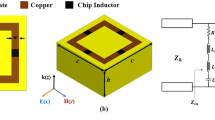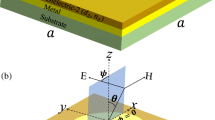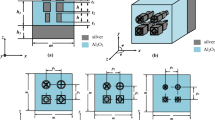Abstract
In this paper, we report the design, simulation, and measurements of a broadband metamaterial absorber (MA) based on a periodic array of multi-layer cross-structure resonators. A perfect narrowband MA consists of cross-structure resonator, dielectric substrate, and continuous metal films, and the absorption frequency can be tunable by changing the geometrical parameters based on L-C resonance circuit theory. Furthermore, the absorption band of our design is effectively extended by simply stacking several such structural layers with different geometrical dimensions. Finally, the 4-layer cross-structure MA is only 2 mm, which can achieve a full width at half maximum (FWHM) bandwidth of 2 GHz by numerical simulations, and 90 % bandwidth of 1.9 GHz by experiments.
Similar content being viewed by others
Avoid common mistakes on your manuscript.
1 Introduction
Electromagnetic (EM) metamaterials (MMs) have been widely explored since the first theoretical [1, 2] and experimental demonstration [3] of their exotic properties. Essentially, MMs are novel artificially structured materials which attain its exotic properties from the unit structure rather than the constituent materials. Since the ultra-thin metamaterial absorber (MA) conception were first proposed by Bilotti et al. [4] and Mosallaei et al. [5], and experiments were demonstrated by Landy et al. at microwave frequencies [6], there has been considerable interest in creating thin EM absorber. To achieve perfect absorption, MA usually consists of three or more layers coupling structures of the electric resonator (the electric resonator also was termed as the frequency selective surfaces), dielectric, and metal wire or sheet layer, which couple separately so as to absorb all incident electric and magnetic fields in resonance frequency [7–13]. On the other hand, according to the effective medium theory, to maximize the absorption magnitude, the relative impedance of the MM structure must be matched to that of free space \( \left( {z(\omega ) = \sqrt {\mu_{\text{eff}} (\omega )/\varepsilon_{\text{eff}} (\omega )} \approx 1} \right) \) [7, 8]. Thus, MMs obtain high absorption properties which mainly originate from dielectric loss and impedance matching at resonance for incident EM waves.
Metamaterial absorber has numerous potential applications, such as thermal imaging, thermal bolometer, wavelength selective radiator, stealth technology, and nondestructive detection [6, 7]. From microwave to optical frequency ranges, several efforts have been made on MAs to achieve polarization-insensitive, wide incident angle, and multi-band absorption [7–13]. Up to now, most MA structure models can achieve dual- or triple-band perfect absorption [14–16], there is little literature about broadband MA. However, constructing broadband MAs remains a challenge and there have been only a few very recent studies, mostly focusing on theoretical and numerical investigations [17–21]. In this work, first, a narrowband perfect MA was proposed and investigated numerically, which consists of cross-structure electric resonator, dielectric substrate, and continuous films. The narrowband peak absorbing properties of MA were studied by changing the geometrical parameters based on L-C resonance circuit theory. Then, the absorption band of the MA can be extended gradually by simply stacking two, three, and four such structural layers with different geometrical dimensions. The overall absorption spectrum is the superposition of individual resonance components and becomes flat at the top over a significant bandwidth in experiments.
2 Narrowband MA and simulated analyses
First of all, we numerically studied a simple composite structure MA that is made of a metallic cross-structure positioned on a lossy PET membrane and a continuous metal film. By pairing the cross-structure electric resonator (CSER) with a ground plane, the magnetic component of the incident wave induces a current in the sections of the CSER that are parallel to the direction of the E-field. The electric and magnetic responses can then be tuned independently and the impedance of the structure matched to free space by varying the geometry of the CSER and the distance between the two metallic elements [20, 21]. This CSER has fourfold rotational symmetry with polarization-insensitivity for incident EM wave. The resonant frequency of the absorption peak is mainly determined by the geometry of the composite structure MA. The scheme of unit cell of narrowband MA is shown in Fig. 1a. A lossy PET (a typical polymer membrane for a PET at microwave frequency) with dielectric ε = 3.1 + 0.11i is used in our numerical simulations. The metal elements in both sides are etched as a 10-μm-thick aluminum film with a frequency-independent conductivity σ = 3.72 × 107 S/m. As shown in Fig. 1a, the lattice constant of the unit cell in both x and y directions are p = 20 mm. The thickness t of the PET layer, the width w, and length l of the cross structure can be adjusted.
Generally, the absorbing properties of MA can be explained effectively by the L-C resonance circuit. For the single layer MA, the corresponding effective L-C resonance circuit mode is shown in Fig. 1b. According to L-C resonance circuit mode, each of the two capacities is formed by the metallic film and an upper or lower half of the cross. The total capacitances C can be described approximately by a two-plate capacitor formula \( C \approx \varepsilon_{r} \varepsilon_{0} lw/4t \) [22]. The total inductance L of the structure is approximately given by \( L \approx \mu_{0} l\ln (t/w) \). Thus, the resonant frequency is given by
where c 0 is the light speed of vacuum and ε r is the dielectric constant of the PET membrane. From Eq. (1), we can deduce that the resonant frequency is less sensitive to the change of thickness t of the PET layer and the width w of the cross structure. However, the resonant frequency is various linearly with the length l of the cross structure. To confirm the above deduce, we simulate the unit cell structure model of the MA (see Fig. 1a) using a finite-integration time-domain algorithm. For a TEM plane wave normal incidence, there is no transmission to be examined, as it is blocked off by the continuous metal film. Thus, only the reflectance needs to be examined in our simulations and experiments. The absorption is calculated by the equation A(ω) = 1 − R(ω) = 1 − |S 11|2. Numerical simulation results of absorption of the narrowband MA for different thickness t of the PET layer, the width w, and length l of the cross structure are presented in Fig. 2a, c, e, respectively.
From Fig. 2b, we can see that resonant peak frequency has a minor red-shift when the thickness t of the PET layer increases from 0.3 to 1.1 mm. As shown in Fig. 2a, it can be observed that the peak value of absorption will decrease when increasing the t (when t > 0.5 mm), which are mainly due to the EM coupling strength of the resonant structure determined by the separation distance t [20]. Thus, we can obtain an optimal value by tuning the thickness of the spacer layer; when t = 0.5 mm, the electric and magnetic responses make the resonant structure impedance matched to the free space, and the absorption achieve near unity at resonant frequency 5.75 GHz (see the red curve of Fig. 2a). Similar to the case of the changing of the separation distance t, as shown in Fig. 2a, b, when the width w of the cross structure increases, the resonant peak frequency has also a minor red-shift, but the peak value of absorption is nearly unchanged. Compared with Fig. 2b, d, a significant red-shift of the resonant peak (with little change in amplitude) is observed when l increases from 11 to 19 mm, there exists linear dependence of the resonant frequency on cross length l (see Fig. 2e). These numerical results (these resonant peaks are at similar frequencies) agree well with our previous deduced formula Eq. (1).
From above simulated analyses of cross-structure narrowband MA, we can conclude that the absorbing properties of MA can achieve tunability by changing the geometrical parameters based on L-C resonance circuit theory. However, this single cross-structure MA is only narrowband absorptivity, which may impede their applications in practice. Thus, in next section, we will focus on extending the bandwidth of MA by assembling of the multi-cross structures based on L-C resonance circuit theory.
3 Extending bandwidth and experiment of MA
The above-mentioned cross-structure MA is much thinner, and is also polarization-insensitivity and wide angle for incident EM wave (not shown), which can be easily fabricated with standard optical lithography processes. However, the absorption band is very narrow and the FWHM bandwidth is about 0.4 GHz. To achieve broadband absorption, we can consider the assembling of the multi-cross structures. Generally, there are two type assembling methods for multi-cross structures with different geometrical parameters. The first one is that multi-cross structures with different geometrical parameters are positioned on a co-planar to ensure that the resonant frequencies could be close to each other. The second is that multi-cross structures with different geometrical parameters are stacking in multi-layers. The first method has been investigated numerically in detail previously [18]; here, we mainly focus on the second method without increasing the total thickness of the composite MA significantly. According to the L-C resonance circuit theory, we can deduce the resonant frequency expression easily of the ith (i = 1, 2, 3…) layer for multi-layer cross structures (see Fig. 1b). The effective L-C resonance circuit model of multi-layer cross-structure MAs is shown in Fig. 1d, the resonant frequency of ith layer is approximately given by
From Eq. (2), we can approximately predict the resonant frequency for the ith layer cross structure. Owing to the different geometrical parameters of the different layer, obviously, the corresponding resonant frequency is different. Thus, these adjacent resonant frequencies could be close to each other by optimal design of geometrical parameters of multi-layer composite structures, finally, achieve broader bandwidth absorption. The bandwidth (BW) of 90 % absorption of composite MA is approximately given by
To confirm the above theory analyses and clearly illustrate the question, we only consider the different configurations of single- and double-layer cross-structure MA. Numerical simulated results of absorption at normal incidence for three different configurations (2-layer corresponds to the double-layer composite MA with different geometrical parameters of cross structure, 1-layer1 and 1-layer2 are corresponding to single-layer MA with different geometrical parameters of cross structure, the corresponding geometrical parameters are indicated in the insets, respectively.) of the cross MA are shown in Fig. 3.
Figure 3a shows three different configurations with different length l of cross structure; it can be observed that the absorption peak is narrow for the 1-layer1 and 1-layer2 resonators alone. While, deploying the two types of resonators in one unit cell (2-layer) which will result in a broader absorption top with a superposition of configurations of 1-layer1 and 1-layer2. According to the Eq. (3), the calculated BW of 2-layer is about 0.43 GHz, and the numerical simulated BW is 0.4 GHz (see Fig. 3a). Further simulated results (see Fig. 3b, which shows three different configurations with different width w of cross structure) also show that the bandwidth increases as the frequency difference between the absorption peaks of 1-layer1 and 1-layer2 increases; however, the dip in 2-layer also becomes undesirably wider and deeper. On the other hand, we can conjecture that when the absorption peaks of 1-layer1 and 1-layer2 are closer by optimal design of geometrical parameters of double-layer composite structures, the absorption top is become flatter, but the overall bandwidth is reduced accordingly.
From above discussions, we can conclude that the broader and flat absorption top of multi-layer composite MA can be obtained by properly designing and assembling the multi-layer cross structures. Next, to verify our theory and simulations, we will further design, fabricate, and measure 1-, 2-, 3- and 4-layer cross-structure MA.
First, we use the above-mentioned algorithm to simulate the absorption of the 1-, 2-, 3- and 4-layer cross-structure MAs, and the corresponding results are displayed in Fig. 5a, respectively. From Fig. 5a, we can clearly see that there exist one absorption peak for 1-layer, two peaks for 2-layer, three peaks for 3-layer and four peaks for 4-layer, respectively. Also, the FWHM for four types of MA is about 0.4, 0.7, 0.95 and 2 GHz, respectively. Obviously, from simulated results, the bandwidth of composite MA is extended effectively by simple assembling of the multi-layer cross structures.
Taking a further step, four designs of the MAs were fabricated using standard optical lithography processes. Each cross-structure metallization was fabricated on a PET lossy substrate with a thickness of 0.3 mm. These boards were sandwiched about another 0.3-mm-thick PET lossy blank substrate to obtain the correct spacing. The substrate consisted of a photosensitized PET lossy board with a 0.38-μm aluminum film thickness. The final result was that the cross elements were separated by different thickness PET substrate in the electromagnetic wave propagation direction, and optimized geometrical parameters of different layers composite MA are listed in Table 1. The experimental geometrical parameters are kept the same with simulations. The photographs of a portion of measured samples are shown in Fig. 4 (10 × 10 unit cell sample with 200 mm × 200 mm). Agilent N5244A PNA-X vector network analyzer connected to the two standard gain horn antennae that produced microwaves in the range of 4–12 GHz were used to measure the MA samples. The experimental measurements were carried out in an EM anechoic chamber and described in detail in Ref. [9].
Figure 5b shows experimental results for the 2-, 3- and 4-layer cross-structure MAs. From Fig. 5b, it can be observed that the bandwidth of 90 % is about 0.5 GHz for 2-layer, 1.2 GHz for 3-layer and 2 GHz for 4-layer, respectively. Especially, for 3- and 4-layer, there exist broader and flatter absorption top. However, the magnitude of absorbing peak will decrease slightly as the layer of composite MA increases. The experimental results are in a reasonable agreement with the simulations. The discrepancy between the experiment and simulation curves maybe caused by several factors; the most significant two are the possibility of a discrepancy in the real and assumed value of the PET dielectric constant and potential thickness no uniformity of the different layers, the tolerances in the fabrication are also not ignored.
Based on the comparisons analyzed above, it could be summarized that the extension of absorption bandwidth of MA is possible by designing the multi-layer cross structures based on L-C resonance circuit theory.
4 Conclusion
In conclusion, we have designed, simulated, and experimentally demonstrated MAs with a broad and flat absorption top. The narrowband peak absorbing properties of MA were studied by changing the geometrical parameters based on L-C resonance circuit theory. Then, the absorption band of the MA can be extended gradually by simply stacking two, three, and four such structural layers with different geometrical dimensions. The experimental results are in a reasonable agreement with numerical simulations. Finally, 4-layer cross-structure MA is only 2 mm, and the bandwidth of 90 % achieve to 2 GHz. Further, extending the absorption bandwidth is possible by properly assembling of the multi-layer cross structures. By scaling down the structures, and if the dimensions of the CSERs are reduced to micro-, nano-, and even lower scale, the broadband MA could also be utilized to function at other frequency bands, such as millimeter wave, terahertz, or even optical range.
References
V.G. Veselago, Sov. Phys. Usp. 10, 509 (1968)
J.B. Pendry, A.J. Holden, D.J. Robbins, W.J. Stewart, IEEE Trans. Microwave Theory Tech. 47, 2075 (1999)
D.R. Smith, W.J. Padilla, D.C. Vier, S.C. Nemat-Nasser, S. Schultz, Phys. Rev. Lett. 84, 4184 (2000)
F. Bilotti, A. Alu, N. Engheta, L. Vegni, in Proceedings of the 2005 Nanoscience and Nanotechnology Symposium—NN 2005 (Frascati, Italy, 2005)
H. Mosallaei, K. Sarabandi, in IEEE Antennas and Propagation Society International Symposium, vol. 1B, p. 615 (2005)
N.I. Landy, S. Sajuyigbe, J.J. Mock, D.R. Smith, W.J. Padilla, Phys. Rev. Lett. 100, 207402 (2008)
N.I. Landy, C.M. Bingham, T. Tyler, N. Jokerst, D.R. Smith, W.J. Padilla, Phys. Rev. B 79, 125104 (2009)
C. Hu, Z. Zhao, X. Chen, X. Luo, Opt. Express 17, 11039 (2009)
Y.Z. Cheng, H.L. Yang, J. Appl. Phys. 108, 034906 (2010)
Q.Y. Wen, H.W. Zhang, Y.S. Xie, Q.H. Yang, Y.L. Liu, Appl. Phys. Lett. 95, 241111 (2009)
H. Tao, C.M. Bingham, D. Pilon, K. Fan, A.C. Strikwerda, D. Shrekenhamer, W.J. Padilla, X. Zhang, R.D. Averitt, J. Phys. D 43, 225102 (2010)
X. Liu, T. Starr, A.F. Starr, W.J. Padilla1, Phys. Rev. Lett., 104, 207403 (2010)
J. Hao, L. Zhou, M. Qiu, Phys. Rev. B 83, 165107 (2011)
J. Lee, S. Lim, Electron. Lett. 47, 478 (2011)
M.H. Li, H.L. Yang, X.W. Hou, Y. Tian, D.Y. Hou, Pro. In. Electro. Res. 108, 37 (2010)
Y.Z. Cheng, Y. Nie, R.Z. Gong, H.L. Yang, Eur. Phys. J. Appl. Phys. 56, 31301 (2011)
H. Wakatsuchi, S. Greedy, C. Christopoulos, J. Paul, Opt. Express 18, 22187 (2010)
H. Luo, Y.Z. Cheng, R.Z. Gong, Eur. Phys. J. B 81, 387 (2011)
W. Ren, G. Zhang, Y. Wu, H. Ding, Q. Shen, K. Zhang, J. Li, N. Pan, X. Wang, Opt. Express 19, 26536 (2011)
Y.Q. Ye, Y. Jin, S. He, Opt. Soc. Am. B 27, 498 (2010)
J. Grant, Y. Ma, S. Saha, A. Khalid, D.R.S. Cumming, Opt. Lett. 36, 3476 (2011)
J. Zhou, L. Zhang, G. Tuttle, T. Koschny, C.M. Soukoulis, Phys. Rev. B 73, 041101 (2006)
Author information
Authors and Affiliations
Corresponding author
Rights and permissions
About this article
Cite this article
Cheng, Y., Nie, Y. & Gong, R. Metamaterial absorber and extending absorbance bandwidth based on multi-cross resonators. Appl. Phys. B 111, 483–488 (2013). https://doi.org/10.1007/s00340-013-5361-1
Received:
Accepted:
Published:
Issue Date:
DOI: https://doi.org/10.1007/s00340-013-5361-1









